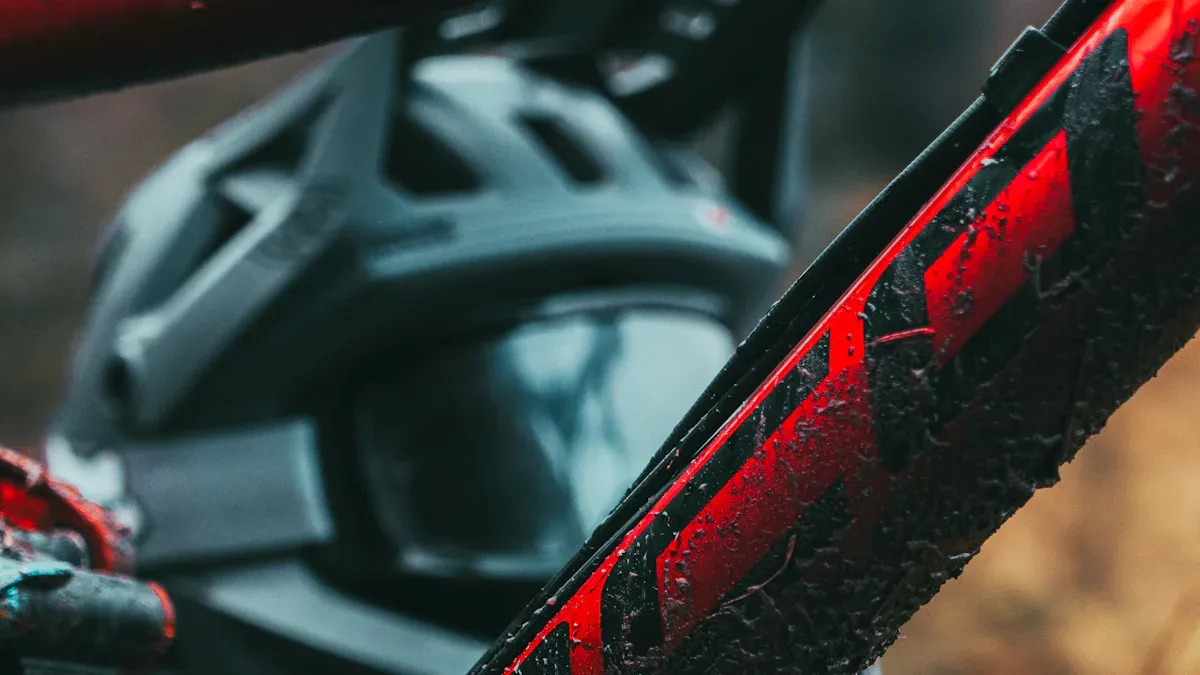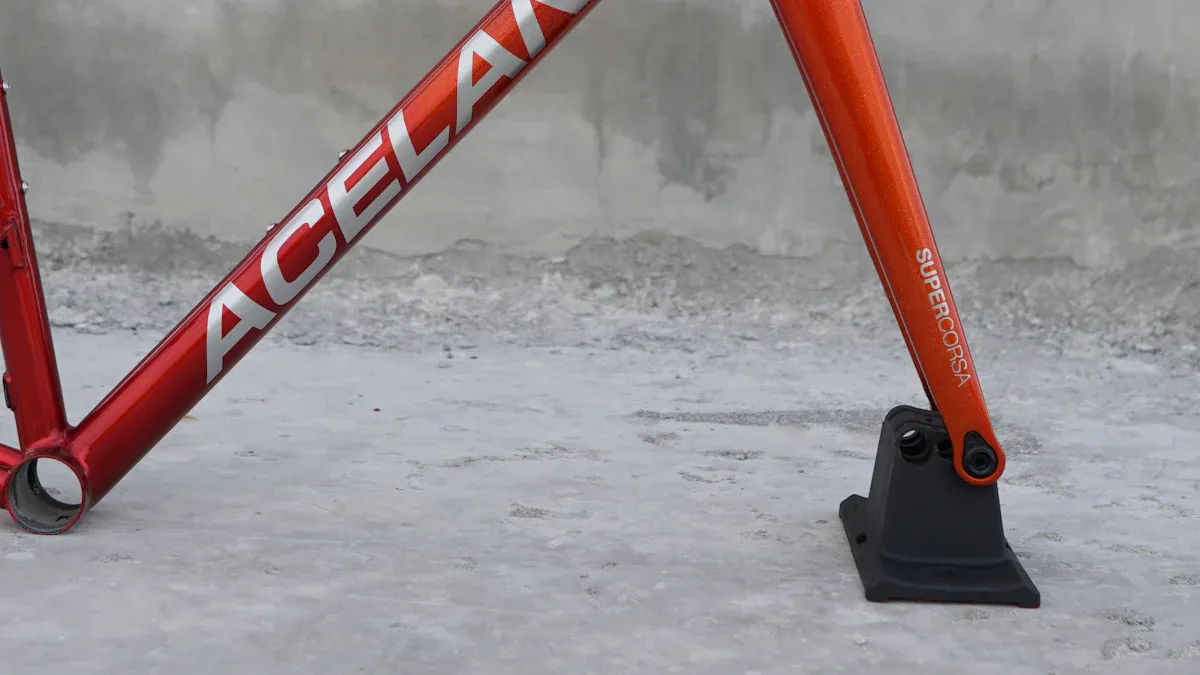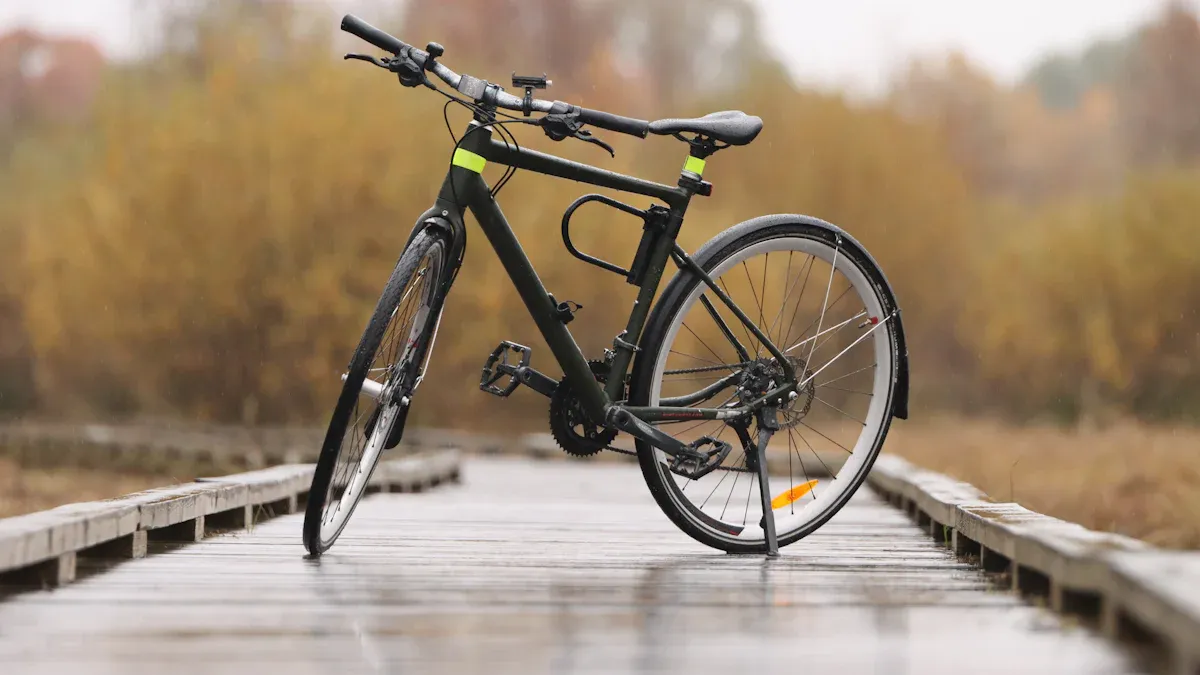
Butted steel bike frames are a popular choice for cyclists. They have a good mix of strength, weight, and comfort. Many cyclists like that steel is better for the environment than other materials. Butted steel frames are strong and last a long time. They usually cost less than titanium or carbon frames. This mix of quality and price makes butted steel bike frames a great choice for your cycling trips.
Key Takeaways
Butted steel bike frames are strong, light, and comfy. This makes them perfect for cyclists.
These frames last a long time, between 10 to 40 years. This gives great value over time.
The butting process makes them lighter but keeps them strong. This helps them compete with aluminum and titanium frames.
Butted steel frames make rides more comfortable by soaking up bumps. This improves the cycling experience.
It is easy to customize and fix butted steel frames. This allows for changes and cheap repairs.
What is Butted Steel?

Butted Steel Tubing Explained
Butted steel tubing is a special kind of steel for bike frames. It has different thicknesses along its length. The ends are thicker for strength where it is needed most. The middle part is thinner to help make the frame lighter. This design gives you a strong and light bike.
Here are some important facts about butted steel tubing:
Butted tubing keeps a steady outer diameter.
A typical double-butted tube is 0.8 mm thick at both ends and 0.5 mm thick in the center.
This setup helps spread stress and makes riding more comfortable.
For example, the top tube usually has a thickness of 0.8 mm at the ends and 0.5 mm in the middle. The down tube may be 0.9 mm thick at the ends and 0.6 mm in the center. This careful design helps you get the best performance from your bike.
Construction Process
Making butted steel bike frames involves several important steps. First, builders collect the materials and tools they need. Then, they cut the steel tubing to the right lengths. After that, they prepare the joints for welding or brazing. Finally, they connect the tubing using methods like MIG or TIG welding.
Butted steel frames use a method where extra material is at the ends of the tubes. This way, the frame is lighter but still strong. This method is different from lugged construction, where material is moved to the outside with lugs.
New advances in material science have led to using strong steels in bike frames. Manufacturers now choose butted steel micro alloys to make frames that are light but strong. This careful choice helps the bike frames perform well and last longer, making them a favorite among cyclists.
Here’s a quick summary of the construction process:
Gather materials and tools needed for frame building.
Cut the steel tubing to the right lengths.
Prepare the joints for welding or brazing.
Connect the tubing using the chosen method (MIG, TIG, etc.).
Making butted steel tubing can cost more than other frame methods. The stronger steels used in butted tubing need more expensive materials and processes. However, this cost is worth it for a strong and high-performing bike frame.
Benefits of Butted Steel

Strength and Durability
Butted steel bike frames are very strong and last a long time. The butting process helps makers change the thickness of the tubing. This gives a better strength-to-weight ratio than regular frames. The thicker ends are strong where needed, while the thinner middle makes the frame lighter. This design helps the frame last longer, making it a good choice for cyclists.
You can expect a butted steel frame to last many years. Under normal cycling conditions, a well-kept frame can last from 10 to 40 years, depending on how you use it. For example, casual riders might enjoy 20 to 40 years, while aggressive riders may see 3 to 10 years. This durability makes butted steel a smart choice for your cycling trips.
Weight Efficiency
Weight efficiency is another big plus of butted steel frames. The butting process helps reduce weight without losing strength. On average, butted steel tubing can save you about 0.25 lbs compared to straight-gauge steel tubing. This weight loss is important for performance, especially on long rides or climbs.
Compared to other materials, butted steel frames usually weigh at or below 18 pounds. This weight is similar to aluminum and titanium frames, which often weigh about the same. The mix of strength and weight makes butted steel a great choice for cyclists who care about performance.
Ride Quality
Many cyclists love the ride quality of butted steel frames. The special features of steel give it a springy feel that makes rough roads more comfortable. This quality helps the frame soak up bumps, making long rides more fun.
Studies show that steel frames, especially those with triple-butted tubing, offer a great ride experience. They are strong where needed, stiff for efficiency, and flexible for comfort. This mix means you can ride on different terrains without getting tired.
Material | Description |
|---|---|
Steel | Soaks up shock to make rough roads softer, giving comfort during rides. |
Triple-butted Steel | Strong where needed, stiff for efficiency, and flexible for a great ride experience. |
Customization and Repairability
Customization is another big benefit of butted steel bike frames. You can easily change these frames by cutting, welding, and adding parts. Professional builders find butted steel easy to modify, like adding mounts and changing tubes.
Butted steel frames are also easier to fix than those made from other materials. Common repair methods include welding and brazing, which usually cost less than fixing aluminum or carbon fiber frames. The thicker ends of butted tubing create stronger joints, making them less likely to break during changes. This skillful work ensures that your bike can change with your needs over time.
Butted Steel vs. Other Materials
When you look at butted steel bike frames and compare them to aluminum and carbon fiber frames, you see some big differences.
Butted Steel vs. Aluminum
Aluminum frames are known for being light and stiff. They usually weigh less than butted steel frames. Here are some key points to think about:
Weight: Aluminum frames are usually lighter than butted steel frames. This makes them a favorite for competitive cyclists.
Strength: Aluminum gives more stiffness and strength for its weight. This means you can have a lighter frame without losing performance.
Durability: Butted steel frames can last longer than aluminum frames in normal conditions. Steel resists fatigue better, so it can handle stress over time.
Material | Weight Comparison | Durability |
|---|---|---|
Butted Steel | Heavier | |
Aluminum | Lighter | Durable if well made |
Butted Steel vs. Carbon Fiber
Carbon fiber frames are often seen as the best for performance. They can be the lightest option out there. However, they have their own pros and cons:
Weight: Carbon fiber frames are usually lighter than both butted steel and aluminum frames. This makes them great for racing.
Ride Quality: Butted steel frames are very comfortable. They soak up road vibrations well, making long rides more fun. In contrast, carbon fiber frames are stiff, which helps with power transfer but can make rides feel rough over long distances.
Cost and Repairability: Carbon fiber frames can be pricey and are easier to damage. Fixing them can be expensive and tricky. Butted steel frames are easier to repair and change.
Frame Material | Weight Comparison | Ride Quality |
|---|---|---|
Butted Steel | Heavier | Comfortable and forgiving |
Aluminum | Lighter | Stiff but less forgiving |
Carbon Fiber | Lightest | Stiff, can be harsh |
Butted steel bike frames have many benefits that make them a great choice for cyclists. Their design makes them strong in important spots without adding extra weight. This mix helps them last longer and be reliable, which is important for professional cyclists. You will enjoy a comfortable ride because of the different wall thicknesses. Thinner parts give some flex, while thicker ends keep the bike stiff when climbing.
Think about these benefits when picking your next bike:
Durability: Butted steel frames last longer than many other options.
Weight: They balance weight and strength well.
Ride Comfort: Steel absorbs bumps, making your ride better.
Repairability: These frames are easy to fix, which is good for long-term use.
Cost-Effectiveness: They give you great value for your money.
With these points in mind, a butted steel bike frame might be just right for your cycling adventures.
FAQ
What is the lifespan of a butted steel bike frame?
A butted steel bike frame can last from 10 to 40 years. This depends on how you use and care for it. Casual riders may have a longer lifespan. Aggressive riders might see a shorter time.
Can I customize my butted steel bike frame?
Yes, you can easily change a butted steel bike frame. You can cut, weld, and add parts to meet your needs. Professional builders find it easy to modify these frames.
How do butted steel frames compare in price?
Butted steel frames usually cost less than titanium or carbon fiber frames. They give a good mix of quality and price. This makes them a great choice for cyclists on a budget.
Are butted steel frames heavy?
Butted steel frames are not heavy compared to other materials. They typically weigh about 18 pounds, which is similar to aluminum and titanium frames. The butting process helps lower weight while keeping strength.
How do I maintain a butted steel bike frame?
To take care of your butted steel bike frame, check for rust often. Clean it with mild soap and water. Store it in a dry place and look at the welds for any signs of wear or damage.
See Also
The Appeal of Carbon Frames for Cyclists in 2025
Key Features That Make Steel Hybrid Bikes Exceptional
Evaluating the Pros and Cons of Steel Mountain Frames
